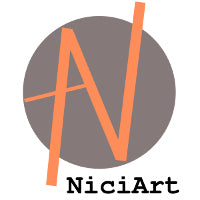Re-thinking venue based strategies for selling art
Share
Just like the internet has given rise to recording artists freeing themselves from the limitations, whims, burdens, and sometimes overbearing expenses of record labels, Artists and Crafters also need to take time out to consider the return on investment in marketing their art. Often blinded by the passion of the creative process, Artists subscribe to venues such as Amazon Handmade or Etsy with the trust that such companies share the same appreciation of their work, while completely ignoring the economics behind such choices.
Similar to investing in a stock or income property, a smart business owner will always ask themselves if they are seeing a return on their investment. As the American dream of simply working hard to get ahead slips into forgotten memories vaguely preserved in black and white photos our grand parents and great grand parents working the factories and farms, success now becomes a challenge of working smarter and not harder.
I answered an Etsy forum post today regarding Amazon Handmade with “The consideration that you must make as business person is whether you are seeing an adequate return on your investment. In my estimation, if Amazon takes 20% and you have a flat rate monthly fee of $39.99 but need not market or concern yourself with being found in search, in other words leave it, forget it, and simply sell, Amazon may prove to be worth the commission. Money can also earn money or be invested to create future business. For example, you may sell $50,000 on Amazon and be paying $10,000 in fees. The temptation is to feel excited about the $50,000 and ignore the $10,000 in fees. Perhaps, it might actually be wiser to only earn $30,000 through your own website one year and invest $10,000 in a marketing company that takes your products to the next level, thereby producing much greater returns in the next year.”
One of my greatest issues with Etsy is how initial and new found success leads to an Etsy addiction, where you spend more and more on promoted listings, invest vast amounts of time into outside promotion, and list new items at your expense in order just to stay relevant in their search. The views and sales turn to an almost Ponzi scheme, where those seemingly successful shops begin to fall out of search, loose traction, and give their sales and views to the next seller in line. Everything on Etsy revolves around stats, a dashboard which prominently displays your comparisons with previous years at motivation, and lets not forget those wonderful stories plastered on the front page promoting fantasies of quitting your day job to be the next millionaire through knitting or metal stamping. For some or even many sellers, Etsy might be the perfect investment and offer steady returns for minimal efforts, but a smart business person will always follow the return on investment instead of the number of favorites.
Shopify, Weebly, and other hosted web-based e-commerce builders offer start-up businesses a standalone site for about $50.00 per month. Initially, these sites are a loosing bet unless you are an extremely talented and aggressive with social media from day one. Growth will be extremely modest in comparison with Etsy, however with out the burdens of de-clumping, links leaving your shop, excessive fees, and keeping up with constant changes, you may very well surpass your maximum earning potential on Etsy.
Even more remarkable for return on investment are open source free e-commerce solutions such as Presta Shop, Open Cart, and Magento. The incredible success of Linux as the de facto server operating system has taught us to take open source options very seriously. You can download and customize Magento into an extremely professional site in about a week. For those proficient in basic PHP, it is very possible to create near custom website and then self host for $10.00 per month. Enterprise grade Gateway options for processing credit cards have much lower rates than Stripe or Authorize. Even on the most frugal start-up budget, anyone can create a fantastic website and slowly promote their products through social media. As you boot-strap, you can move on to paid services such as Google Adwords, Facebook Ads, Pinterest Ads, and almost limitless other options.
Regardless of the path you choose, be sure to ask yourself whether you are seeing a return on investment (ROI). If not it is time switch your strategy.
